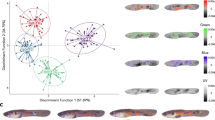Summary
Partial suppression of the frizzled plumage of heterozygous Frizzles is induced by a recessive autosomal gene, mf, which is independent of the gene for frizzling.
This modifying gene is manifested when homozygous in all birds heterozygous for frizzling and in about 40 per cent. of those homozygous for frizzling.
Modified heterozygotes may show only a slight ruffling of the body feathers, but always have abnormal feathers in the primary remiges. Modified homozygotes have less curling of the feathers in all parts of the body.
The manifestation of frizzling is also apparently conditioned by growth rates of feathers, which vary with age, in different regions of the body and within certain feathers.
The modifying gene is widely distributed among domestic fowls, presumably because of its selective advantage in their ancestors.
Similar content being viewed by others
References
Benedict, F. G.,Landauer, W. andFox, E. L. (1932). “The physiology of normal and Frizzle fowl, with special reference to the basal metabolism.”Bull. Storrs agric. Exp. Sta. No. 177.
Fisher, R. A. (1930).The Genetical Theory of Natural Selection. Oxford: University Press.
—— (1935). “Dominance in poultry.”Philos. Trans. B,225, 195–226.
Hutt, F. B. (1930). “The genetics of the fowl. I. The inheritance of frizzled plumage.”J. Genet. 22, 109–27.
—— (1932). “Eight new mutations in the domestic fowl.”Proc. Sixth Internat. Congr. Genetics,2, 96–7.
Juhn, M., Faulkner, G. H. andGustavson, R. G. (1931). “The correlation of rates of growth and hormone threshold in the feathers of fowls.”J. exp. Zool. 58, 69–111.
Lancefield, D. E. (1918). “An autosomal bristle modifier, affecting a sex-linked character.”Amer. Nat. 52, 462–4.
Landauer, W. (1932). “The effect of irradiating eggs with ultra-violet light upon the development of chicken embryos.”Bull. Storrs agric. Exp. Sta. No. 179.
—— (1933). “A gene modifying frizzling in the fowl.”J. Hered. 24, 152–6.
Landauer, W. andDunn, L. C. (1930). “The ‘frizzle’ character of fowls.” Ibid.21, 290–305.
Larionov, W. T., Woitkewitsch, A. A. andNowikow, B. G. (1932). “Die gegenseitige Wirkung der Teile während der Regeneration des Gefieders.”Roux Arch. Entw. Mech. Organ. 127, 446–55.
Lillie, F. R. andJuhn, M. (1932). “The physiology of development of feathers. I. Growth-rate and pattern in the individual feather.”Physiol. Zoöl. 5, 124–84, Pls. I–VIII.
Rattray, R. S. (1927).Religion and Art in Ashanti. Oxford: University Press.
Author information
Authors and Affiliations
Additional information
The greater part of this investigation was conducted at the University of Minesota, but the work was completed at Cornell University.
Rights and permissions
About this article
Cite this article
Hutt, F.B. Genetics of the fowl. Journ. of Genetics 32, 277–285 (1936). https://doi.org/10.1007/BF02982682
Issue Date:
DOI: https://doi.org/10.1007/BF02982682




